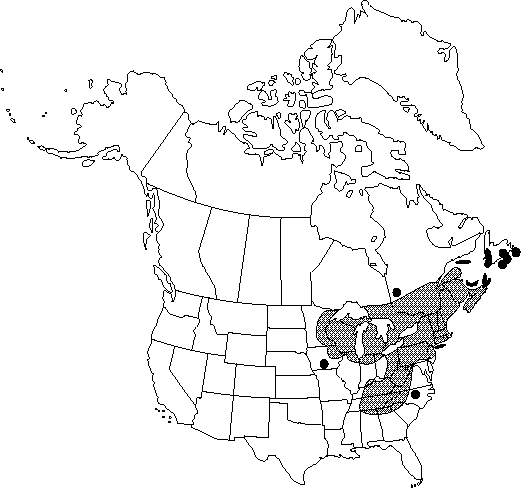Betula alleghaniensis
Bull. Torrey Bot. Club 31: 166. 1904.
Trees, to 30 m; trunks straight, crowns narrowly round. Bark of young trunks and branches dark reddish brown, in maturity tan, yellowish, or grayish, lustrous, smooth, irregularly exfoliating, or sometimes darkening and remaining close; lenticels dark, horizontally expanded. Twigs with odor and taste of wintergreen when crushed, glabrous to sparsely pubescent, usually covered with small resinous glands. Leaf blade narrowly ovate to ovate-oblong with (9–)12–18 pairs of lateral veins, 6–10 × 3–5.5 cm, base rounded to cuneate or cordate, margins sharply doubly serrate, teeth coarse, rather irregular, apex acuminate; surfaces abaxially usually moderately pubescent, especially along major veins and in vein axils, often with scattered, minute, resinous glands. Infructescences erect, ovoid, 1.5–3 × 1–2.5 cm, generally remaining intact after release of fruits in late fall; scales sparsely to moderately pubescent, lobes diverging proximal to middle, central lobe tapering to narrow tip, lateral lobes ascending or partially extended, broader, rounded. Samaras with wings narrower than body, broadest near summit, not or only slightly extended beyond body apically. 2n = 84.
Phenology: Flowering late spring.
Habitat: Stream banks, swampy woods, and rich, moist, forested slopes
Elevation: 0–500 m
Distribution

St. Pierre and Miquelon, N.B., Nfld. and Labr. (Nfld.), N.S., Ont., P.E.I., Que., Ala., Conn., Ga., Ill., Ind., Iowa, Ky., Maine, Md., Mass., Mich., Minn., N.H., N.J., N.Y., N.C., Ohio, Pa., R.I., S.C., Tenn., Vt., Va., W.Va., Wis.
Discussion
Betula alleghaniensis is a characteristic tree of the northern Appalachians and the hemlock hardwoods forest of the Great Lakes region. It was formerly widely known by the illegitimate (superfluous) name B. lutea F. Michaux.
Native Americans used Betula alleghaniensis medicinally as an emetic or cathartic, to remove bile from intestines, as a blood purifier, as a wash for "Italian itch," and as a diuretic (D. E. Moerman, as Betula lutea).
Betula alleghaniensis is very closely related to B. lenta, which it resembles in many features (T. L. Sharik and R. H. Ford 1984). A distinctive feature is usually its freely exfoliating bark, although in certain populations the bark remains close and dark (B. P. Dancik 1969; B. P. Dancik and B. V. Barnes 1971).
Betula alleghaniensis Britton × B. papyrifera Marshall has seldom been reported, but it may actually be more common than realized in the northeastern states. In most features it is intermediate between the parents (B. V. Barnes et al. 1974).
Betula ×purpusii Schneider (= Betula alleghaniensis Britton × B. pumila Linnaeus, 2n = 70) is a rather common hybrid wherever the parent species occur together. The large shrubby plants show strikingly intermediate leaf characteristics.
Selected References
None.
